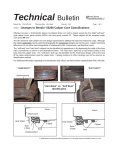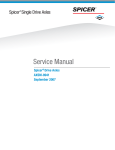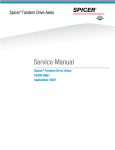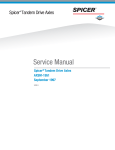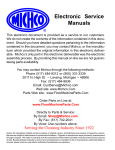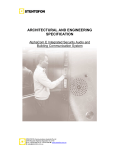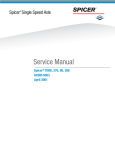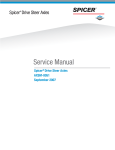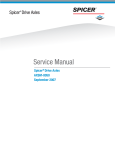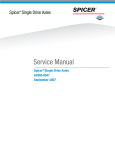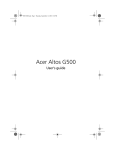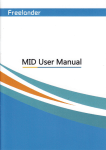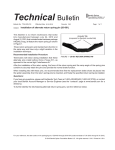Download Service Manual
Transcript
Spicer Drive Axles ® Service Manual Spicer® Drive Axles AXSM-0866 September 2007 TABLE OF CONTENTS Axle Identification ................................................................................. 2 Model Identification Numbering System ......................................... 3 Gear Set Identification ......................................................................... 3 Axle Lubricant Recommendations ..................................................... 4 General Precautions .............................................................................. 5 Axle Components .................................................................................. 6 Removal ................................................................................................... 7 Differential Carrier from Axle Housing Differential from Carrier Differential Disassembly ...................................................................... 8 Pinion Removal ....................................................................................... 10 Cleaning and Inspection ...................................................................... 11 Pinion Assembly ..................................................................................... 12 Differential Assembly ............................................................................ 14 Pinion Position ....................................................................................... 15 Pinion Setting Chart ............................................................................. 16 Differential Installation ......................................................................... 18 Ring Gear and Pinion Tooth Contact Pattern ................................. 19 Wheel Bearing Adjustment ................................................................. 20 Fastener Torques and Axle Specifications ........................................ 21 Installation of Differential Carrier Into Axle Housing ................... 22 Recommended Service Tools .............................................................. 23 GENUINE SPICER SERVICE PARTS Should an axle assembly require replacement component parts, it is recommended that Spicer Heavy Axle Service Parts be used. Spicer Heavy Axle Service Parts are manufactured under the same rigid specification as are original equipment axle components. This assures the customer who uses genuine Spicer service parts, maximum reliability for a Spicer Heavy Axle assembly. They may be obtained through your vehicle manufac- turer. The use of non-original Spicer service parts may cause premature component failure and may void the warranty. The items included in this book are currently being offered as service parts at the time of printing. The part numbers and illustrations are provided specifically for reference purposes only. Therefore, Spicer reserves the right to update this manual without notice or liability. 1 AXLE IDENTIFICATION JULIAN D ATE CODE DA 97 070 MODEL YEAR 070 97 Mylar Tag Aluminum Tag All axle assemblies are identified with two tags. One located on the differential carrier, and the other located on the right hand side of the axle housing. Two types of tags may be found on the axle, an aluminum tag that is riveted on the assembly or a coated mylar tag. include customer part number, line set number, and the last six digits of the vehicle serial number. The aluminum axle assembly tag contains the following items: serial number, according to the julian date, Dana part number, and the model. The mylar axle assembly tag contains the following items: Dana part number, julian date code, axle model, and ratio. Optional items include customer part number, line set number, and the last six digits of the vehicle serial number. The aluminum differential carrier tag contains the following items: serial number, according to the julian date code, the Dana part number, and ratio. The mylar differential carrier tag contains the following: Dana part number, julian date code, and ratio. Optional items DANA PART NUMBER MODEL YEAR DAY OF YEAR DAY OF YEAR SERIAL NUMBER CUSTOMER PART NUMBER (OPTIONAL) DANA PART NUMBER SN 07095A R44CA103-4X RATIO 4.44 Carrier Tag JULIAN DATE CODE Carrier Tag LAST SIX DIGITS OF VEHICLE SERIAL NUMBER (OPTIONAL) DANA PART NUMBER LINE SET NUMBER (OPTIONAL) CUSTOMER PART NUMBER (OPTIONAL) MODEL SERIAL NUMBER DANA PART NUMBER SN 07095B R44AF112-3 JULIAN DATE CODE MODEL Axle Assembly Tag Axle Assembly Tag LAST SIX DIGITS OF VEHICLE SERIAL NUMBER (OPTIONAL) LINE SET NUMBER (OPTIONAL) 2 J210-S MODEL MODEL IDENTIFICATION NUMBERING SYSTEM J Family (J & W) 175 Nominal Load Carrying Capacity (175 = 17,500 Lbs.) (190 = 19,000 Lbs.) (210 = 21,000 Lbs.) (220 = 22,000 Lbs.) (230 = 23,000 Lbs.) S N Gearing Type (S = Single Reduction) Options (N = *No-SPIN® Differential) * No-SPIN® is a registered trademark of Tractech GEAR SET IDENTIFICATION Manufacturer's Date- Date gear set was made. PINION ETCH SPICER TRADEMARK Spicer Trademark- Company logo and location of manufacturing facility. +15 597000C0- Part number of pinion. (TYPICAL) Tooth Combination(i.e. 41-11)- Indicates the pinion has 11 teeth and the ring gear has 41 teeth which results in a 3:73:1 ratio. 260 41-11 TOOTH COMBINATION Matched Set Number- Spicer ring gears and pinions are manufactured as matched sets. Both ring gear and pinion are marked with a corresponding number (i.e. 260), which identifies them as a matched set. PART NUMBER HEAT CODE SPICER TRADEMARK MFG. DATE MATCHED SET NUMBER 260 L10 A gear set that does not have the same match set numbers should not be run together. If either ring gear or pinion require replacement, a new matched set must be used. BACKLASH ETCH Backlash Etch- Indicates backlash setting for assembly. Pinion Etch- Indicator for proper pinion position shim stack up. (See Pinion Position Pg. 15) 3 AXLE LUBRICANT RECOMMENDATIONS APPLICATION To ensure proper lubrication and operating temperature, correct lubricants and lubricant levels must be obtained. On Highway RECOMMENDED GEAR LUBRICANTS PETROLEUM BASED SYNTHETIC BASED** MILES INTERVAL MILES INTERVAL 100,000 1 Year 250,000 3 Year and 50,000 On-Off Highway 1 Year 100,000 1 Year * Severe Service Mineral or Synthetic based hypoid gear lubricants that meet or exceed military specification MIL-L-2105D, and API service classification GL-5, are the minimum requirements for use in Spicer Medium and Heavy Duty Drive Axles. * Severe service includes any applications operating at or near maximum GVW or GCW ratings. This includes normally wet or dusty environment, or consistent high load and low speed applications. The table below indicates which SAE viscosities are recommended for various temperature ranges the vehicle will encounter. ** Includes Semi-Synthetic blends that meet MIL-L-2105D specifications. AFTER OVERHAUL OR CHANGE INTERVALS Fill the axle assembly to the bottom of housing fill hole as shown in the illustration below. It is recommended that following an overhaul, each side of the axle be jacked up separately to approximately six inches and held into position for one minute. This procedure will allow adequate lubricant to flow into the wheel ends and help eliminate the possibility of premature damage to wheel bearings and seals. Lower the vehicle to the floor and allow ten minutes for lube to return to normal level. Check and refill assembly to bottom of fill hole to replace the lubricant that was directed into the wheel ends. AMBIENT AIR TEMPERATURE SERVICE Recommended lubricant change intervals are dependent on the application and operating environment. The following chart should be used to establish proper change intervals. SUBMERSION OR DEEP WATER FORDING NOTE: Lubricant close enough to the bottom of the fill hole to be seen or touched is not sufficient. Lubricant must be level with the fill hole. In the event the carrier housing should become submerged in water, particularly if over the vent or breather, it is recommended that the lubricant be drained and all internal parts be inspected for water damage and/or contamination. Reassemble the carrier to the housing and refill with specified gear lubricant. 4 GENERAL PRECAUTIONS IMPORTANT READ THIS SECTION BEFORE STARTING ANY SERVICE PROCEDURES Accordingly, anyone who uses a service procedure or tool different than shown must insure that their safety, and the vehicle's safety, will not be jeopardized by the service method selected. GENERAL AXLE DESCRIPTION This manual covers maintenance and rebuild procedures for the Spicer J175-S, J190-S, J210-S, J220-S, J230-SB and W230-S rear drive axle assemblies. The Spicer Heavy Duty Single Reduction Rear Drive Axle is a full floating hypoid gear carrier assembly in one piece HSLA steel axle housing. The hypoid pinion is straddle mounted, having two tapered roller bearings ahead of the pinion teeth for forward and rear thrust, and also having a third bearing behind the pinion teeth for radial load. The differential itself uses four precision forged pinion mate gears, a forged cross, and precision forged side gears. A fresh supply of lube oil is fed to the differential assembly by our Spicer positive flow lube system. Axle shafts and drive pinion splines are of the rolled involute type. Follow the sections of this manual that cover individual service needs. END YOKES AND FLANGES SAFTEY PRECAUTIONS Service personnel should use a wash tank for thorough cleaning of parts just prior to reassembly. CAUTION: Hammering on end yokes can close in the bearing bores or misalign yoke lugs and result in early failures of journal needle bearings or other driveline components. Serious damage can also be done internally to the ring and pinion set or pinion bearings by hammering on external parts. End yokes or companion flanges should be removed or installed using the recommended methods outlined in this manual. CLEANLINESS Axle components should be steam cleaned prior to removal from the vehicle. Dirt is abrasive and will cause premature wear of otherwise serviceable parts. Proper service and repair of vehicle components is important to the safe and reliable operation of all motor vehicles. This applies particularly to driving axles such as the ones described in this manual. The procedures recommended and described in this manual are tested, and effective methods for performing service operations. Follow each procedure closely, making use of both the text and illustrations. Some of these service procedures show the use of certain tools designed specifically for the operation being performed. They are shown as a preferred means of performing the operation. It is not practical to anticipate and advise the service trade of all possible alternative methods, and of all possible hazardous consequences that could occur. Safety glasses should be worn at all times when assembling or disassembling axles. CAUTION BRAKE LININGS CONTAIN NON-ASBESTOS FIBERS BREATHING BRAKE DUST MAY BE HAZARDOUS TO YOUR HEALTH AND MAY CAUSE SERIOUS RESPIRATORY OR OTHER BODILY HARM. AVOID CREATING DUST DO NOT REMOVE BRAKE DRUM WITHOUT PROPER PROTECTIVE EQUIPMENT. DO NOT WORK ON LININGS WITHOUT PROPER PROTECTIVE EQUIPMENT. DO NOT REPLACE LININGS WITHOUT PROPER PROTECTIVE EQUIPMENT. DO NOT ATTEMPT TO SAND, GRIND, CHISEL, FILE, HAMMER OR ALTER BRAKE LININGS IN ANY MANNER WITHOUT PROPER PROTECTIVE EQUIPMENT. FOLLOW 0.S.H.A. STANDARDS FOR PROPER PROTECTIVE DEVICES TO BE USED WHEN WORKING WITH BRAKE MATERIALS. 5 AXLE COMPONENTS NOTE: Torque specifications, shown on illustration, apply only to J Model. See Page 21 for W Model torque specifications. Housing Vent Plug Axle Shaft Fill Plug (35-45 Lb-Ft) (47-61 N-m) Differential Bearing Cap Temperature Sensor Plug (35-45 Lb-Ft) (47-61 N-m) Adjusting Ring Pinion-Up Components Magnetic Drain Plug (35-45 Lb-Ft) (47-61 N-m) Ring Gear Differential Side Gear Differential Bearing Cup Differential Cross Shaft Differential Bearing Cone Differential Case Bolt (115-135 Lb-Ft) (156-183 N-m) Differential Bearing Cap Bolt (295-340 Lb-Ft) Differential Gear Thrust Washer (397-460 N-m) Differential Case Cap Half Differential Bearing Cap Washer Differential Case Flange Half Ring Gear Rivet (45-50 tons) (41-45 metric tonnes) Differential Pinion Mate Cotter Pin Differential Pinion MateThrust Washer Differential Case Nut Ring Gear Bolt Kit Pinion Pilot Bearing Adjusting Ring Lock Pinion Inner Pinion Bearing Cone Carrier Housing Pinion Bearing Spacer (Selective) Pinion Bearing Cage Pinion Bearing Cage Bolt (160-180 Ft-Lb) (217-244 N-m) Carrier Mounting Bolt (240-260 Lb-Ft) (325-352 N-m) Inner Pinion Bearing Cup Pinion Position Shim(s) Washer Outer Pinion Bearing Cup Outer Pinion Bearing Cone No-Spin® Differential Bearing Preload Spacer Pinion Oil Seal End Yoke Assembly Flanged Hex Nut (900-1,200 Lb-Ft) (1,220-1,627 N-m) 6 REMOVAL 9. Install two 1/2"-13 bolts into threaded holes provided in carrier housing flange. Figure 1. Be certain carrier is balanced properly on jack, and remove top two carrier mounting bolts. Remove differential carrier assembly from the axle housing. DIFFERENTIAL FROM AXLE HOUSING NOTE: Steam clean axle assembly. 1. Block wheels. 2. Remove magnetic drain plug and drain lubricant 10. Mount carrier assembly in a suitable rebuild stand. (See Recommended Service Tools, pg. 23). 3. Disconnect drive shafts at the rear U-joint. NOTE: If end yoke and/or seal is to be replaced, loosen yoke nut at this time. Differential Carrier Removal Complete 4. Remove axle shaft stud nuts and lock washer, or cone locks if used. DIFFERENTIAL FROM CARRIER 5. Remove axle shafts. If a gasket is assembled between the hub and shaft, discard the old gasket and replace it with a new one at the time of assembly. CAUTION: Do not strike the flange directly with a steel hammer or sledge. This may crack and splinter material, possibly causing serious or fatal injury. Do not pry or chisel axle flange away from hub, damage to sealing surfaces could occur. 6. Remove axle shafts. 7. Support the differential carrier assembly on a roller jack. Secure as necessary to prevent it from falling off the jack when removed from the housing. Figure 2 1. Remove adjusting ring locks from bearing caps. 2. Match mark one differential bearing cap and leg with center punch or chisel for reference during reassembly. See Figure 2. 8. Loosen the carrier-to-housing mounting bolts. Remove all bolts except top two. These two bolts will prevent the carrier assembly from falling. 3. Loosen four bearing cap retainer bolts. 4. Loosen adjusting rings, relieving bearing preload. Threaded Removal Hole 5. Remove four bearing cap retainer bolts. 6. Remove bearing caps. 7. Remove adjusting rings. 8. Carefully lift the ring gear and differential subassembly out of the carrier. NOTE: Use care not to damage the ring and pinion gears. If either gear is damaged, it must be replaced as part of a matched set. Threaded Removal Hole Figure 1 7 Removal of Differential Complete DIFFERENTIAL DISASSEMBLY Adjusting Ring Differential Bearing Cup Differential Bearing Cone Ring Gear Used on W Model carriers that do not have oil scoope cast integrally to the flange half of the differential case. Differential Side Gear Differential Case Bolt (115-135 Lb-Ft) (156-183 N-m) Differential Cross Shaft Differential Case Flange Half Differential Gear Thrust Washer Ring Gear Rivet (45-50 tons) (41-45 metric tonnes) Differential Case Cap Half Differential Pinion Mate Differential Pinion MateThrust Washer Differential Case Nut NOTE: Torque specifications, shown on illustration, apply only to J Model. See Page 21 for W Model torque specifications. 1. Match mark differential case halves with punch or chisel for correct alignment in reassembly. See Figure 3. 2. Remove differential case bolts and lift off differential case cap half. 3. Remove differential gear thrust washer and differential side gear. 4. Lift out differential cross shaft, differential pinion mates, and differential pinion mate thrust washers. 5. Remove second differential side gear and differential side gear thrust washer. Figure 3 8 DIFFERENTIAL DISASSEMBLY 6. If differential bearing cones are to be replaced, remove old bearings using a suitable puller. See Figure 4. CORRECT PROCEDURE Case Ring Gear CAUTION: Always use a soft hammer or H.D. plastic head hammer to strike punch. NOTE: Do not use a chisel to remove rivet heads, damage to differential case may result. Figure 4 INCORRECT PROCEDURE NOTE: Inspect all parts, including the machined surfaces of the case halves. If any gears are to be replaced, they must be replaced in sets. Inspect thrust washers for scoring and excessive wear. Replace all worn or damaged parts. Ring Gear 7. When it is necessary to remove ring gear from the differential case, carefully center punch each rivet head. Using a 9/16" drill bit, drill through rivet heads to depth shown. Next, use a rounded type punch to drive out remaining portion of the rivet. Differential Disassembly Complete 9 Case PINION REMOVAL Pinion Inner Pinion Bearing Cone Pinion Pilot Bearing Pinion Bearing Spacer (Selective) Pinion Bearing Cage Pinion Bearing Cage Bolt (160-180 Ft-Lb) (217-244 N-m) Inner Pinion Bearing Cup End Yoke Assembly Pinion Position Shim(s) Flanged Hex Nut (900-1,200 Lb-Ft) (1,220-1,627 N-m) Outer Pinion Bearing Cup Outer Pinion Bearing Cone Bearing Preload Spacer NOTE: Torque specifications, shown on illustration, apply only to J Model. See Page 21 for W Model torque specifications. Pinion Oil Seal Washer 1. Remove pinion bearing cage mounting bolts. Figure 5. 2. Remove pinion and cage assembly from carrier housing. If difficulty is encountered in removing pinion assembly from carrier housing, place brass drift on inner end of pinion and tap lightly. 5. Remove pinion from cage assembly. 6. Remove bearing preload spacer and save for use in reassembly. 7. Remove the old pinion seal and discard. Always replace it with a new seal at the time of reassembly. NOTE: Retain shims for possible use during reassembly. 8. Lift out outer pinion bearing cone. 9. Remove inner pinion bearing cup, using a suitable adapter and press or puller. CAUTION: Do not nick bearing bore. Yoke Puller 10. Remove outer pinion bearing cup, using same procedure as step 9. 11. Remove pinion pilot bearing from end of pinion. 12. Remove inner pinion bearing cone from pinion. Pinion Removal Complete Figure 5 3. Holding yoke stationary, remove flanged hex nut and washer. Use of a torque multiplier may be necessary. 4. Remove the end yoke using a suitable puller. See 10 CLEANING AND INSPECTION CLEANING GEARS 1. Parts should be cleaned with emulsion cleaners or petroleum base cleaning solvent. NOTE: Alkaline type solutions may cause damage to machined surfaces and should be avoided. 2. Make sure interior of axle housing is clean prior to 3. reassembly. Clean all gasket surfaces of old material. Inspect gears for excessive wear or damage. Replace gears that are pitted, scored, broken, or worn. DRYING Use soft, clean, lintless towels or rags to dry components after cleaning. Bearings should not be dried by spinning with compressed air. This can damage mating surfaces due to the lack of lubrication. SHAFTS After drying, parts should be coated with a light coat of lubricant or rust inhibitor to prevent damage from corrosion. If parts are to be stored for a prolonged period, they should be wrapped in wax INSPECTION paper. Prior to reassembly, inspect parts for signs of excessive wear or damage. Replacement of these parts can prevent premature failure and costly downtime. Inspect shafts for nicks or scoring. SPLINES Inspect all splines for excessive wear, distortion from twisting, and cracking. BEARINGS Bearing surfaces should be inspected for pitting, excessive wear, or overheating. HOUSINGS THRUST WASHERS Inspect thrust washers for scoring and cracking. Inspect housing for stripped threads and bending fatigue. 11 PINION ASSEMBLY Pinion Inner Pinion Bearing Cone Pinion Pilot Bearing Pinion Bearing Spacer (Selective) Pinion Bearing Cage Pinion Bearing Cage Bolt (160-180 Ft-Lb) (217-244 N-m) Inner Pinion Bearing Cup End Yoke Assembly Pinion Position Shim(s) Flanged Hex Nut (900-1,200 Lb-Ft) (1,220-1,627 N-m) Outer Pinion Bearing Cup Outer Pinion Bearing Cone Bearing Preload Spacer NOTE: Torque specifications, shown on illustration, apply only to J Model. See Page 21 for W Model torque specifications. Pinion Oil Seal Washer 7. Place pinion bearing spacer, that was removed during disassembly, onto pinion. 8. Place pinion bearing cage onto inner pinion bearing cone. 9. Install outer pinion bearing cone and washer on to pinion. 10. Inspect end yoke or flange for grooves in seal surface caused by contaminants. If grooves can be detected with fingernail, then end yoke must be repaired with a CR approved repair sleeve replaced. Figure 6 1. Press inner pinion bearing cone onto pinion. 11. Install end yoke onto pinion without seal, to allow proper setting of bearing preload. Torque pinion nut to 900-1200 Lb-Ft(1,220-1,627 N-m) See Figure 7. 2. Press pinion pilot bearing onto nose of pinion. 3. Stake nose of pinion in 9 places, using a center punch or equivalent tool. See Figure 6. 4. Install inner pinion bearing cup into pinion bearing cage. Yoke Installation Tool DST 1009 5. Install outer pinion bearing cup into pinion bearing cage. 6. Use a feeler gauge or shim stock (.0015 Approx.) to ensure bearing cups are completely seated in bearing bores. This is necessary for proper pinion position. Figure 7 12 PINION ASSEMBLY 12. Measure torque to rotate with an inch-pound torque wrench. Torque measurements should be taken every fourth revolution and should read between 10-30 in-lbs of bearing preload. SeeFigure 9. To measure preload with spring scale, clamp the end yoke horizontally in a soft-jawed vise. Attach one end of cord to a bolt hole in the pinion bearing cage and attach the other end of the cord to the spring scale. Rotate pinion cage and attach the other end of cord to the spring scale. Rotate pinion bearing cage by pulling scale. Read scale during fourth revolution. Scale reading must be between 3-9 lbs. See Figure 8. NOTE: If bearing preload does not fall within allowed limits, preload can be increased by using a thinner spacer and decreased by using a thicker spacer. .001" change in preload spacer thickness will change torque to rotate approximately 30 in-lbs. NOTE: Individual carriers may vary slightly. Pinion bearing preload spacers are available in several thicknesses. Refer to service parts booklet for kits of commonly used preload spacers. Always measure each spacer before assembly to ensure correct thickness. Figure 8 NOTE: Closer adjustment can be made by sanding the next thicker spacer to desired thickness using emery cloth on a flat surface. CAUTION: Wash spacer thoroughly of emery cuttings before installing on pinion. NOTE: Spicer recommends that new torque prevailing nuts be used. 13. Apply Loctite #680(green) to threads. 14. Install new pinion oil seal. Apply a small amount of light grease to the seal lip. Prior to installing yoke. Figure 9 15. Use torque multiplier and torque flanged hex nut to 900-1,200 Lb-Ft (1,220-1,627 N-m). 13 Pinion Assembly Complete DIFFERENTIAL ASSEMBLY NOTE: Torque specifications, shown on illustration, apply only to J Model. See Page 21 for W Model torque specifications. Adjusting Ring Differential Bearing Cup Differential Bearing Cone Ring Gear Differential Side Gear Differential Case Bolt (115-135 Lb-Ft) (156-183 N-m) Differential Cross Shaft Differential Case Flange Half Differential Gear Thrust Washer Ring Gear Rivet (45-50 tons) (41-45 metric tonnes) Differential Case Cap Half Differential Pinion Mate Differential Pinion MateThrust Washer Differential Case Nut cones during remainder of assembly to prevent damage of bearings. Correct rivet head shape when properly compressed 3. Apply a small amount of gear lubricant to all mating surfaces. This will aid in assembly by keeping parts together and providing initial lubrication. 4. Place differential gear thrust washer and differential side gear in differential case flange half. 5. Assemble differential pinion mates and differential pinion mate thrust washers onto differential cross shaft. Place assembly into differential case flange half. 1. If ring gear was removed from the differential case, reinstall it at this time. Bolt ring gear to differential case in two places, 180o apart, before compressing rivet; this will eliminate ring gear runout. Use a hydraulic or mechanical press and riveting fixture. Pressure requirement per rivet is 45-50 tons or (41-45 metric tonnes). 6. Place remaining differential side gear and differential side gear thrust washer in position on differential pinion mates. NOTE: Ring gear and pinion must be replaced as a matched set only. 7. Assemble case halves, making sure match marks are lined up. 2. Press differential bearing cones onto differential case halves. Place differential bearing cups on 8. Install differential case bolts and torque evenly to 115-135 Lb-Ft (156-183 N-m). 14 Differential Assembly Complete PINION POSITION Ring gears and pinions are supplied in matched sets only. Matching numbers on both the pinion and ring gear are etched for verification. If a new gear set is being used, verify the numbers of each pinion and ring gear before proceeding with assembly. (See Gear Set Identification, Page 3) Pinion position is based on the nominal mounting distance measured from the centerline of the ring gear to the nose of the pinion. This dimension is controlled by selectively shimming between the pinion cage assembly and the carrier housing. The nominal dimension is 3.976 in. (100.990 mm). Figur 0 iguree 1 10 NOTE: Because the step plate must be taken into consideration, the thickness of the step plate (.400 in. (10.16 mm)) needs to be added to the measured value for the correct micrometer distance. NOTE: Be sure mounting surfaces and shims are free of burrs and dirt prior to assembly as they will affect pinion position. 4. On the machined end of each pinion either a plus (+), minus (-), or a zero (0) will be etched. (See Gear Set Identification, Pg. 3) This number represents the amount in thousandths of an inch (.001) to be added or subtracted from the nominal dimension for the best running position for that particular gear set. 1. To establish the correct nominal dimension by using a pinion setting gauge, install pinion and cage assembly into the carrier housing without shims. Tighten pinion cage bolts to correct torque specifications. (See Axle/Torque Specifications, Pg. 21) Failure to tighten properly may result in incorrect gear adjustment. EXAMPLE: 2. Attach the step plate clamp assembly to the carrier mounting flange. Locate step plate clamp screw over center of pinion. Install step plate under clamp screw and tighten to hold step plate securely in position. If pinion is etched +3, the required mounting distance is more than nominal by .003 in. (.076 mm). This means the pinion would require .003 in. (.076 mm) thicker shim between pinion bearing cage assembly and carrier housing that a pinion etched with "0". If the pinion is marked -3, the shim required between pinion gearing cage assembly and carrier housing would be .003 in (.076 mm) thinner than if pinion was etched "0". NOTE: Be sure lugs on bottom of step plate straddle the bearing staking indentions on end of pinion, or false reading may occur. Also, make sure differential side bearing bores are clean and free of nicks. 3. Remove any burrs and wipe clean differential bearing bore I.D.'s. Turn micrometer 90 deg. to step plate. Install assembled pinion setting gauge into bearing bores of carrier housing until fully seated. Adjust micrometer so it is directly over end of step plate. Run the micrometer thimble down to measure the distance between the center of the ring gear and the step plate. See Figure 10. Make a note of this dimension. 15 PINION POSITION 5. Pinion shims are available in the following thicknesses. Inches MM NOTE: Be sure mounting surfaces and shims are free of dirt and nicks prior to assembly or leaks will occur and pinion position can be affected. .005 .127 7. Install pnion and pinion cage assembly into carrier. .010 .254 NOTE: Studs can be used to assist in alignment. .030 .762 8. Tighten pinion cage to carrier bolts. (See Axle/ Torque Specifications, Pg. 21) 6. Position shims on carrier housing so oil return holes align properly. Use a minimum of three shims in a pack. If the pack is made of different shim thicknesses, install the thinnest shims on both sides of the pack for maximum sealing. 9. An alternative to using the pinion setting gauges is to follow the procedure described in the following section. Pinion Position Complete PINION SETTING CHART When a new gear set is being installed, use a micrometer to measure the thickness of the old pinion position shims. Measure each shim separately and add together to get the total thickness of the original build-up. If either or both the pinions are etched beyond the values on this chart, follow the same procedure to establish correct pinion position. For example if the old pinion is etched –12 and the new pinion is etched +9, add .021 inch to the thickness of the original shims. NOTE: If old shims are bent or mutilated they should be replaced. If a new gear set is being used, notice the (+), (–) or "0" etching on both the old and the new pinions, and adjust the thickness of the shims to compensate for the difference of these two figures (as shown in table on next page). After determining the new total build up of pinion position shims, round the figure off to the nearest multiple of .005 inch. Use the Pinion Setting Chart on the next page as a guideline to set the pinion. For example, if the old pinion is etched +2, and the new pinion is –2, subtract .004 in. from the thickness of the original shims used to position the pinion. 16 PINION SETTING CHART 17 DIFFERENTIAL INSTALLATION Oil Pick-Up Plate Figure 11 1. Three differential cases are used with the W Model carriers, depending on the ratio. Two of the cases have two oil pick-up plates attached. Clean and coat bolts with Loctite #271 or its equivalent. Assemble and torque bolts to 7-9 Lb-Ft (9-12 N-m) 5. Loosen adjusting ring on tooth side of ring gear 1 notch and tighten adjusting ring on flange side of ring gear 1 notch. Repeat process until backlash is eliminated. Tighten adjusting ring on tooth side of the ring gear 2 or 3 notches or until proper backlash and side bearing preload are established. CAUTION: Differential assembly must be aligned within bearing bores before preload is applied or damage to bearings could occur. 6. Check ring gear and pinion backlash in four equally spaced positions around the ring gear with a dial indicator as shown. Acceptable backlash tolerance is .006"-.012". See Figure 12. 2. Install ring gear and differential assembly into carrier housing. CAUTION: To avoid damage of the ring gear and pinion, care should be used when installing the ring gear differential assembly into the carrier housing. NOTE: If backlash tolerance varies more than .003" (.080 mm) between the four positions, remove the differential and determine the cause. 3. Be sure side bearing cups are seated on bearing cones. Assemble differential bearing caps, with match marks in proper location. Clean differential bearing cap bolts and washers and coat threads with Loctite #277 or its equivalent. Install bearing cap bolts and tighten enough to eliminate visible space between differential bearing cap and carrier housing. Do not torque the cap bolts at this time. 7. Once backlash is set, torque the differential bearing cap bolts to 295-340 Lb-Ft (397-460 N-m) Check backlash after torquing cap bolts. 4. Install adjusting rings. Tighten both adjusting rings until end play is eliminated and there is backlash between the ring gear and pinion. See Figure 11. Figure 12. 18 Differential Installation Complete RING GEAR AND PINION TOOTH CONTACT PATTERN The procedures to the right are to be used to establish proper gear tooth pattern after assembly of the carrier is complete. NOTE: If matched sets are being reused, measure and record backlash before disassembly, and reassemble to the same backlash. This will match ring and pinion gears to the established wear patterns. Hand rolled patterns will cover less area than the gear pattern established by previous service. STEP 1. Paint 1/4 ring gear with marking compound on both the drive and coast side. STEP 2. Rotate ring gear at least one complete revolution in both directions while load is being applied. CORRECT GEAR PATTERNS FOR GLEASON CUT GEARS LIGHTLY LOADED HEAVILY LOADED NOTE: Tooth contact pattern, on this axle model, can be moved only by adjusting backlash. The contact pattern can be moved in the direction of heel-to-toe, and toe-to-heel; Depth of the pattern cannot be adjusted. If an acceptable tooth contact pattern cannot be established within limits of backlash, contact Spicer Service at 1800-666-8688. 19 , , ,, ,,,, ,, , ,,,, , , WHEEL BEARING ADJUSTMENT NOTE: Wheel bearings should be adjusted following vehicle manufacturers recommended maintenance schedule. 1. Block wheels not being adjusted to insure that vehicle will not roll. Release emergency brake. 2. Raise wheel to be adjusted off of the ground. Make certain wheel rotates freely. 3. Remove axle shaft. 4. Remove outer adjusting nut and lock if tabs are broken. 5. Torque inner wheel nut to 50 Lb-Ft (68 N-m) while rotating wheel one direction, then the other direction. Back off inner nut 1/4 turn. NOTE: When replacing wheel bearings, new bearings must be re-seated to insure maximum service reliability. After the hub and bearings are assembled in place on the spindile, install the inner adjusting nut. Tighten the inner adjusting nut to 120 - 140 Lb-Ft (163-190 N-m), while rotating the hub to seat the bearings. Back off the adjusting nut 1/2 turn and follow the proedure outlined in step #5. LUBRICANT LEVEL 6. Install lock against inner wheel nut, with locking portion positioned on either the flat side of inner nut or peak of inner nut, as shown. 7. Install outer wheel nut and torque to 250-275 Lb-Ft (340-373 N-m). Rotate wheel in both directions. Wheel must rotate freely, with out binding. 8. Bend one tang of lock over flat portion of outer wheel to secure. 9. Remove old axle flange gasket and clean mating surfaces of hub and axle flange. 10. Install new axle flange gasket. 11. Install axle shaft. Torque axle nuts to specifications. (See Axle/Torque Specifications, Pg. 21) 20 AXLE/TORQUE SPECIFICATIONS Hex Head Fasteners Position Flanged Hex Nut Pinion Bearing Cage Bolts Differential Bearing Cap Bolts Differential Case Bolts Carrier Mounting Bolts Differential Case Oil Scoop Bolts Model All J W All J W All W Thr ead Thread 1-3/4" - 12 9/16" - 12 5/8" - 11 3/4" - 10 9/16" - 18 5/8" - 18 5/8" - 11 1/4" - 20 Gr ade Grade 8 8 8 8 8 8 8 8 Lb-Ft 900 - 1,200 115 - 135 160 - 185 275 - 320 115 - 135 160 - 185 160 - 185 7-9 N-m 1,220 - 1,627 155 - 183 217 - 250 370 - 435 156 - 183 217 - 250 217 - 250 9 - 12 Flange Head Fasteners Position Model Flanged Hex Nut Pinion Bearing Cage Bolts All J W Differential Bearing Cap Bolts All Differential Case Bolts J W Carrier Mounting Bolts All Fill & Magnetic Drain Plugs All Axle Flange to Wheel Hub Nuts J175-S Only J190-S thru W230-S Axle Flange to Wheel Hub Nuts J175-S Only J190-S thru W230-S Thr ead Thread 1-3/4" - 12 9/16" - 12 5/8" - 11 3/4" - 10 9/16" - 18 5/8" - 18 5/8" - 11 3/4" - 14 5/8" - 18 3/4" - 16 5/8" - 18 3/4" - 16 Gr ade Grade 8 8 8 8 8 8 8 8 5 5 8 8 Nylok Nylok Steel Steel Lb-Ft 900 - 1,200 160 - 180 240 - 260 390 - 410 115 - 135 160 - 185 240 - 260 35 - 45 125 - 145 217 - 240 160 - 185 275 - 320 N-m 1,220 - 1,627 217 - 248 330 - 358 536 - 563 156 - 183 217 - 250 330 - 358 47 - 61 170 - 195 290 - 325 217 - 250 370 - 435 Axle Specifications It em Item Pinion Bearing Preload* Pull Scale Torque Wrench Differential Ring Gear to Pinion Backlash Ring Gear Rivet Pressure Model U.S. Me tric Metric J, W J, W 3 - 9 Lb-Ft 10 - 30 Lb-in 1.4 - 4.0 Kg 1.1 - 3.4 N-m J W J W .006" - .012" .012" - .016" 45 - 50 tons 50 tons .23 - .33 mm .30 - .40 mm 41 - 45 tonnes 45 tonnes Lubrication Lube Capacity (Approx.**) Lube Capacity (Approx.**) Pinion Nominal Dimension J 31.5 pints 15.0 liters W 34.5 pints 16.5 liters J 3.7695" 95.745 mm W 4.2845" 108.826 mm * Pinion bearing preload is established prior to installation of pinion seal. ** Capacity will vary depending on the housing angle in each vehicle. Fill to lower edge of fill hole in rear of axle housing as shown on page 4. 21 INSTALLATION OF DIFFERENTIAL CARRIER INTO AXLE HOUSING 1. Thoroughly clean the inside of the carrier housing and inspect the housing mounting surface for nicks and general cleanliness. Stone the surface if necessary to remove burrs or nicks. Bolt holes must also be checked, to see that they are free of contaminants. 21) 9. Clean magnetic drain plug and install. Torque magnetic drain plug to 35-45 Lb-Ft (47-61 N-m). Fill unit to proper level with hypoid gear lubricant. 10. Install fill plug and torque to 35-45 Lb-Ft (47-61 N-m). NOTE : Lubricant close enough to bottom of fill hole to be seen or touched is not sufficient. Lubricant must be level with the fill hole. Loctite #518 Gasket Eliminator Figure 13 CAPACITIES (Approximate*): Model Pints 2. Apply an .125 inch (3.175 mm) diameter bead of Loctite #518 gasket eliminator onto the axle housing mounting flange and around each bolt hole. See Figure 13. J Models W Models 15 16.5 * Lube capacity will vary depending upon the housing angle in each vehicle. Capacities given above are for an angle of 4°. Fill to the lower edge of the fill hole in the axle housing as shown above. 3. Thread two studs into the axle housing 1800 apart. This will eliminate rotation of the carrier assembly after it makes contact with the gasket material. 4. Install the carrier assembly into the axle housing. If reinstalling used bolts, clean the mounting bolts, and coat with Loctite #277, and install. Tighten bolts evenly in cross pattern. Torque bolts 240-260 Lb-Ft (325-352 N-m). 5. Allow one hour cure time for gasket material before adding hypoid gear lubricant. 6. Remove the old axle flange gasket and clean mating surfaces of the hub and axle flange. 7. Install the new axle flange gasket. 8. Install the axle shafts to proper location. Torque the axle flange nuts to vehicle manufacturers specifications. (See Axle/Torque Specifications, Pg. 31.5 34.5 Liters 22 RECOMMENDED SERVICE TOOLS ORDER NUMBER DESCRIPTION ILLUSTRATION DST1001 CARRIER STAND TORQUE MULTIPLIERS DST1002 DST1003 Maximum 1,000 ft-lbs Maximum 2,000 ft-lbs DST1004 DST1005 Maximum 4,000 ft-lbs Maximum 12,000 ft-lbs DST1006 YOKE REMOVER, BAR TYPE DST1009 INSTALLER, DIFFERENTIAL YOKE (11/4 "-12) 23 RECOMMENDED SERVICE TOOLS ORDER NUMBER ILLUSTRATION DESCRIPTION DST1000-1 SEAL INSTALLATION TUBE HANDLE DST1000-2 PINION SEAL INSTALLER ALL SERVICE TOOLS AVAILABLE FROM OTC DIVISION: Service Tools 655 Eisenhower Drive Owatonna, MN 55060 Telephone: 1-800-533-0492 Fax Number: 1-800-578-7375 24 Aftermarket Group ForDana spec‘ing or service assistance, call 1.800.621.8084 or visit our website at www.spicerparts.com PO Box 321 Toledo, Ohio 43697-0321 Warehouse Distributor: Dana Commercial Vehicle1.800.621.8084 Products Group OE Technology Dealers: 1.877.777.5360 3939 Drive Maumee, Ohio, USA 43537 www.spicerparts.com www.dana.com AXSM-0866 Printed in U.S.A. Copyright Dana Limited, 2012. All rights reserved. Dana Limited.




























